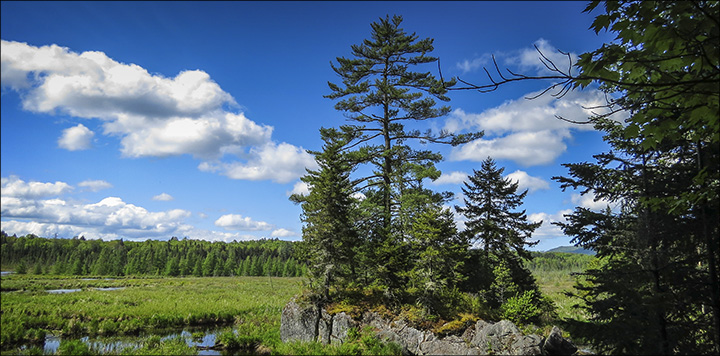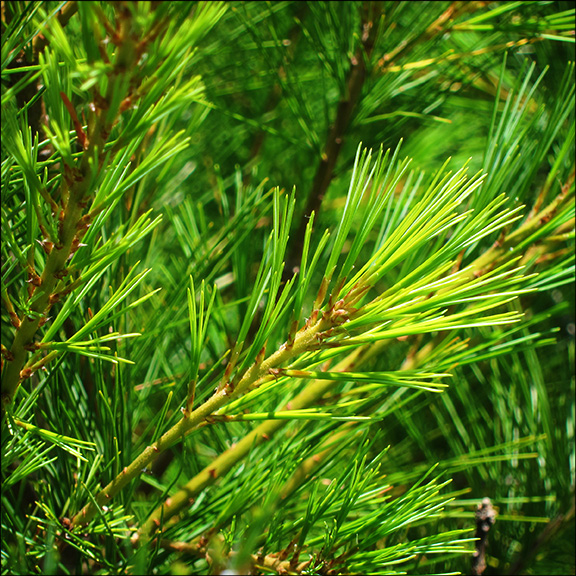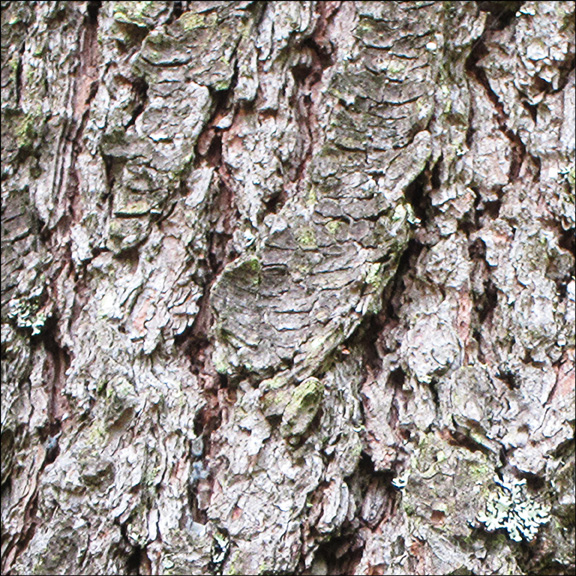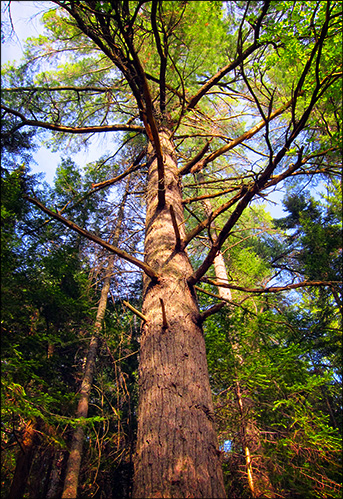Trees of the Adirondacks:
Eastern White Pine (Pinus strobus L.)
 Trees of the Adirondack Park: Eastern White Pine from the Barnum Brook Trail overlook (31 May 2014)
Trees of the Adirondack Park: Eastern White Pine from the Barnum Brook Trail overlook (31 May 2014)
| This page is no longer being updated. For an updated and expanded version of this material, see: Eastern White Pine (Pinus strobus). |
The Eastern White Pine (Pinus strobus L.) is a large conifer which flourishes throughout the Adirondack Mountains and can be seen on some portions of all trails at the Paul Smiths VIC. Also referred to as the White Pine or the Weymouth pine, it is the state tree of Maine (the Pine Tree State). The Eastern White Pine is also a part of the logo of Paul Smith's College. The leaning pine in the logo is an Eastern White Pine which stood on the campus between what is now the Phelps Smith Administration Building and the Joan Weill Adirondack Library. When the tree was chopped down by vandals in 1971, it was estimated to have been over a century old.

The Eastern White Pine is the largest eastern conifer, often growing up to 150 feet tall and up to 40 inches in diameter, depending on the soil. The tallest tree on record in New York State is an Eastern White Pine. This tree, which can be seen in the Elders Grove (also known as the 1675 grove) in nearby Easy Street, is 160.4 feet tall, with a circumference of 13.1 feet.
The Eastern White Pine normally grows with a straight trunk and a crown of horizontal. parallel branches, with one row added a year, becoming broad and irregular as the tree ages. Because the tree grows higher than surrounding trees, it is subject to wind damage and the branches on the part of the tree that faces the winds often fall off.
This tree has clustered needles, growing five to a cluster. Each needle is three to five inches long, bluish green in color, and soft and flexible to the touch. The long, thin needles seem to whisper in the breeze.

The bark of the Eastern White Pine is gray to brown and develops large broad scales as the tree ages. On young trees, the bark is rather thin, smooth, and greenish-brown in color. On older trees, the bark becomes deeply fissured and dark grayish-brown in color. The cones are four to eight inches long and about one inch thick, with a pointed white tip. Cones are green when immature and turn yellow-green to light brown when ripe. Cones generally remain attached for one to several months after ripening in the fall of the second season.
Uses of the Eastern White Pine: The Eastern White Pine is one of the most important timber trees in the Northeast. Its wood is light, durable, and easy to work. It is used for construction, millwork, trim, and pulpwood. The wood of the pine provides good lumber for toys, boxes, cabinet work, and similar items. The tree is also used in Christmas tree plantations and as ornamental plants. It is also used for windbreaks and screens around fields and campsites. Pitch can be obtained from the resin and reportedly has been used for waterproofing canoes and as a wood preservative. In the colonial period, the long, straight trunks of the Eastern White Pine were used to make ship’s masts.
The plant has also edible uses, although it should be avoided by individuals suffering from asthma or bronchitis. The seed can be ingested raw or cooked, and is mainly used as a flavoring agent. The fresh needles reportedly can be brewed into an aromatic tea that is rich in vitamins. Also, the inner bark is said to have been used as a thickener in soups, when dried and ground into a powder.
This plant reportedly was employed medicinally by several native North American Indian tribes, primarily as an antiseptic. It was used extensively in the treatment of skin complaints, wounds, burns, and boils. A poultice made from the pounded inner bark was said to be useful in the treatment of cuts, sores and wounds. The Algonquin reportedly used the wetted inner bark as a poultice on the chest in treating colds. The Delaware used an infusion of twigs for pulmonary diseases,
The Eastern White Pine is also valuable as food for wildlife. Species of songbirds that consume seeds of the Eastern White Pine include: Yellow-bellied Sapsucker, Black-capped Chickadee, White-breasted Nuthatch, Pine Warbler, Pine Grosbeak, and Red Crossbill. Mammals that eat the seeds, bark, and foliage of white pine include beaver, snowshoe hares, Eastern cottontails, porcupine, red squirrels, mice, and white-tailed deer.
Distribution of the Eastern White Pine: The Eastern White Pine grows in a wide variety of soils, ranging from light, sandy soils to heavy, textured soils. It occurs in a wide variety of wet to dry habitats, including mesic forests, successional fields, shrublands, lake edges, rises in bogs and marshes, and elsewhere. It can grow in nutritionally poor soil. It can tolerate drought, but cannot tolerate atmospheric pollution. The tree flourishes in southern Canada and in the eastern portions of the US, south to northern Georgia and Alabama. It is present in every county in New York State. The climate over the range of the Eastern White Pine is cool and humid; it grows where the July temperature averages between 65 and 74 degrees.

The Eastern White Pine at the Paul Smiths VIC: The Eastern White Pine, a canopy tree, is one of the signature trees of the Adirondacks. It is one of the indicator plants for the Boreal Forest Community. It is often seen together with other conifers, such as the Balsam Fir. In mixed hardwood-conifer forest communities, the Eastern White Pine may be observed growing in the same area as deciduous trees, such as the Paper Birch.
Because much of the Paul Smiths VIC property consists of Boreal Forest or mixed hardwood-conifer forest communities, this tree is distributed widely throughout the VIC's 3,000 acres. The tree may be observed on at least portions of virtually all of the trails.
There are a number of notable examples of the Eastern White Pine on the VIC property, including the photogenic Eastern White Pine growing on the rock island near the edge of Heron Marsh (above). This tree may be viewed from the second overlook of the Barnum Brook Trail -- a popular spot to observe, photograph, and paint Heron Marsh and Saint Regis Mountain. Another particularly majestic specimen is found on the upland portion of the Boreal Life Trail. Several large Eastern White Pines are found near the Heron Marsh Trail, between the second overlook and the floating bridge.
References
- United States Department of Agriculture. Forest Service. Silvics of North America. Eastern White Pine. Retrieved 7 January 2015.
- United States Department of Agriculture. Plants Database.
- Lady Bird Johnson Wildflower Center. Native Plant Database.
- Flora of North America. Plant Database.
- NatureServe Explorer. Online Encyclopedia of Life.
- University of Wisconsin. Robert W. Freckmann Herbarium.
- New York Flora Association. New York Flora Atlas.
- University of Michigan. Native American Ethnobotany. A Database of Foods, Drugs, Dyes and Fibers of Native American Peoples, Derived from Plants.
- Plants for a Future. Database.
- Trees of the Northern Forest Trail Walk
- Barnum Brook Tree Game. Paul Smith’s College VIC.
- Michael Wojtech. Bark: A Field Guide to Trees of the Northeast (UPNE, 2011).
- George A. Petrides. A Field Guide to Eastern Trees (Boston: Houghton Mifflin Company, 1998), pp. 34, 35, 159.
- John Kricher. A Field Guide to Eastern Forests. North America (Boston: Houghton Mifflin, 1998), pp. 62-67, 122.
- Neil Surprenant. Paul Smith's Adirondack Hotel and College (Arcadia Publishing, 2009), p. 105.
- Bill McLaughlin. "Famous Leaning Pine at Paul Smiths College Cut Down by Vandals," Adirondack Daily Enterprise, 12 November 1971, p. 1. Retrieved 8 January 2015.
